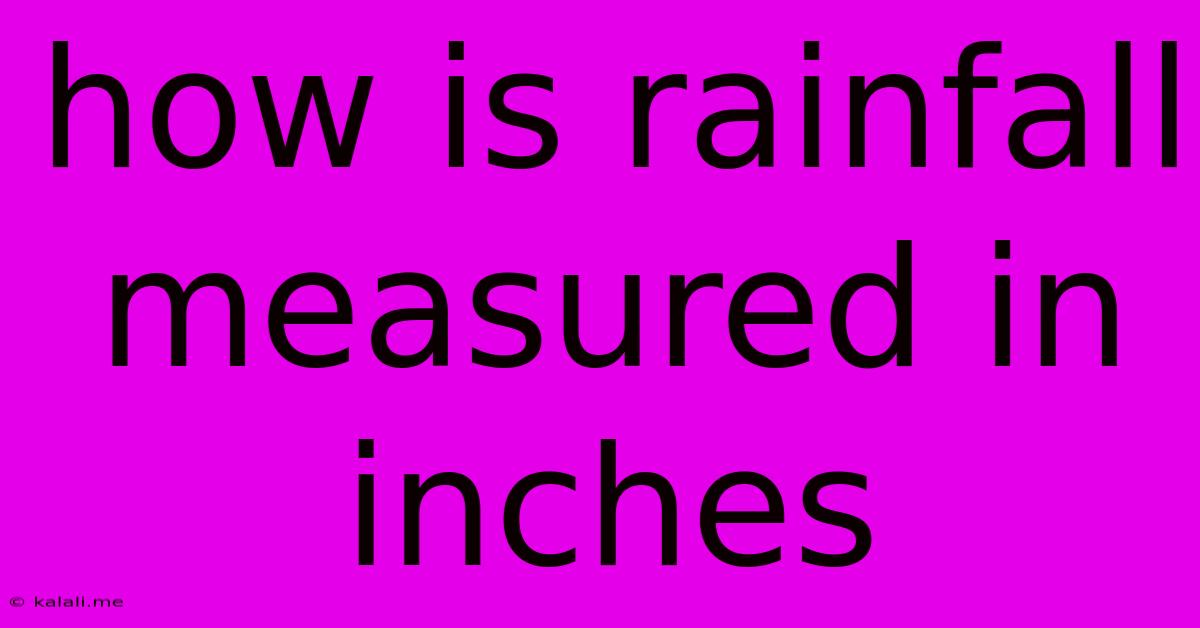How Is Rainfall Measured In Inches
Kalali
Jun 03, 2025 · 3 min read

Table of Contents
How is Rainfall Measured in Inches? A Comprehensive Guide
Knowing how much rain has fallen is crucial for everything from agriculture and water resource management to weather forecasting and flood prediction. This article explains the methods used to measure rainfall, focusing on the common unit of inches. We'll explore the tools, techniques, and the science behind converting rainfall data into meaningful information.
Rainfall, a vital component of the hydrological cycle, is measured in various units globally, but inches remain a prevalent measurement in many parts of the world, including the United States. Understanding how these measurements are obtained is key to interpreting weather reports and appreciating the impact of precipitation on our environment.
The Humble Rain Gauge: The Heart of Rainfall Measurement
The most common tool for measuring rainfall is the rain gauge, a simple yet effective instrument designed to collect and quantify rainwater. There are various types, but they all share the same basic principle: collecting rainwater in a container and then measuring the accumulated depth.
-
Standard Rain Gauge: This consists of a cylindrical container with a funnel at the top to collect rainwater. The collected water is then measured using a graduated measuring cylinder, typically calibrated in inches (or millimeters). The key is to ensure the funnel's diameter is significantly larger than the measuring cylinder to minimize measurement error.
-
Tipping Bucket Rain Gauge: This sophisticated version uses a tipping bucket mechanism. As the bucket fills with rain, it tips over, emptying its contents and triggering a sensor. This sensor then records the number of times the bucket tips, allowing for automated rainfall measurement and data logging, often used in weather stations.
Beyond the Simple Measurement: Accuracy and Calibration
While simple in design, accurate rainfall measurement requires attention to detail:
-
Placement: Rain gauges must be placed in an open area, away from buildings, trees, or other obstructions that could interfere with rainfall collection. Wind can significantly affect accuracy, so a sheltered location is preferable.
-
Regular Cleaning: Regular cleaning of the rain gauge is crucial to prevent debris from accumulating and affecting the measurement accuracy.
-
Calibration: It's essential to ensure that your rain gauge is properly calibrated. This may involve comparing it against a known standard or using a precision measuring cylinder to ensure accurate reading in inches.
-
Data Recording: Meticulous record-keeping is essential. This includes noting the date, time, and amount of rainfall measured (in inches) for analysis and long-term monitoring.
Understanding Rainfall Data: Inches and Beyond
Rainfall data expressed in inches represents the depth of water accumulated in a specific area over a given period. For example, one inch of rainfall means that if all the rainwater collected in a specific location were evenly distributed over a flat surface, it would form a layer of water one inch deep.
While inches are common, other units like millimeters are used internationally. Conversion is straightforward: 1 inch equals approximately 25.4 millimeters.
Rainfall Measurement in Meteorology and Beyond
Rainfall data is crucial for a wide range of applications:
-
Agriculture: Farmers rely on rainfall data to make informed decisions regarding irrigation, planting, and crop management. Accurate rainfall measurements are key to predicting crop yields and optimizing resource allocation.
-
Hydrology: Hydrologists use rainfall data to understand and manage water resources, predict flooding, and design water infrastructure.
-
Weather Forecasting: Accurate rainfall measurements are fundamental inputs for weather models, enabling more accurate and timely weather predictions.
-
Climate Change Studies: Long-term rainfall data provides valuable insights into climate patterns and trends, assisting in the understanding and mitigation of climate change impacts.
In conclusion, accurately measuring rainfall in inches, or any unit, is a crucial element in comprehending our climate and managing our resources effectively. The simple rain gauge, while seemingly basic, is a fundamental tool providing crucial information for various scientific disciplines and everyday life. Understanding the method behind the measurement ensures a deeper appreciation of the data and its significance.
Latest Posts
Latest Posts
-
Why Didnt Iroh Become Fire Lord
Jun 04, 2025
-
Water In Filter Area Of Dishwasher
Jun 04, 2025
-
The Needs Of Many Outweigh The Needs Of The Few
Jun 04, 2025
-
Do Servers Still Run With Chunk Loader Minecraft
Jun 04, 2025
-
Is The Niv Bible A Catholic Bible
Jun 04, 2025
Related Post
Thank you for visiting our website which covers about How Is Rainfall Measured In Inches . We hope the information provided has been useful to you. Feel free to contact us if you have any questions or need further assistance. See you next time and don't miss to bookmark.